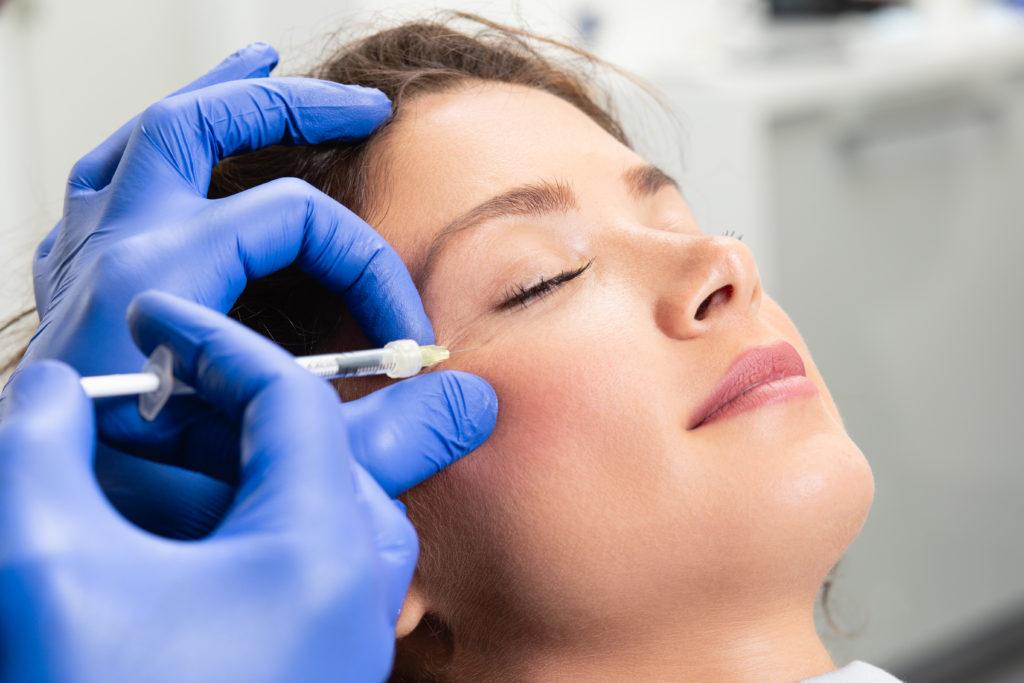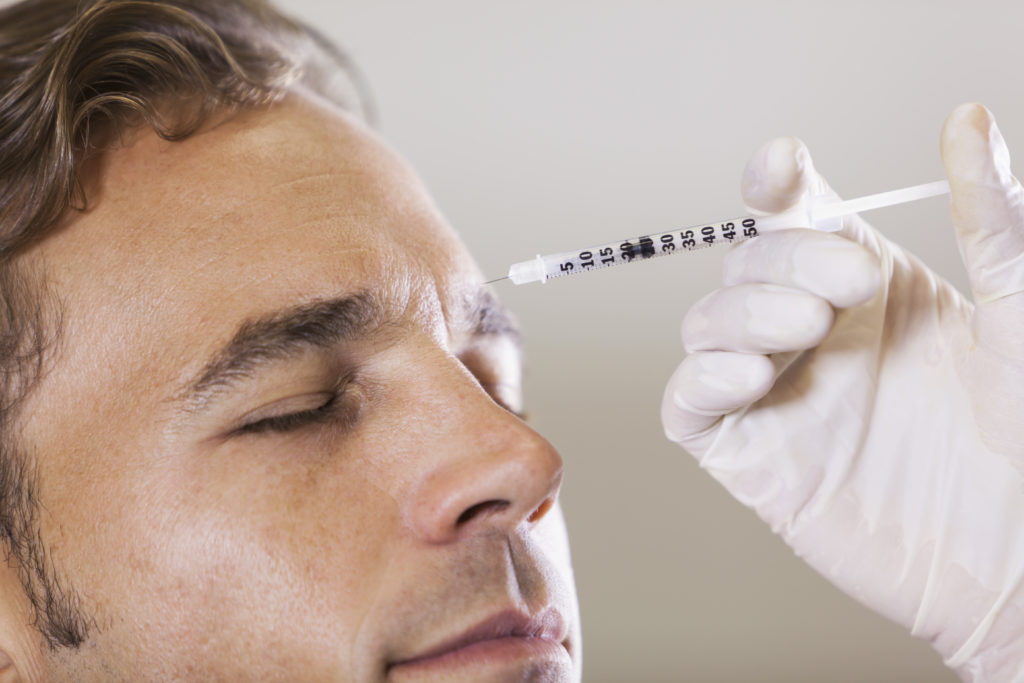Botox
Botox® is one of the world’s most famous brand names. Ever since the FDA approved Botox® for the cosmetic treatment of wrinkles in 2002, Botox® injections have been the world’s most popular cosmetic procedure, non-surgical and surgical, every year.
Why all the adoration? Botox® works. Plain and simple. It effectively erases wrinkles and lines on the upper third of the face for about four months. We provide Botox® for our patients at all of our locations in the Denver, Colorado area.
What is Botox?

Botox® is made from the botulinum toxin type A, the same bacteria that cause botulism. That sounds scary, but it’s really not. Way back in the late 1940s, scientists discovered that when injected in minute amounts into a muscle the botulinum toxin stopped the muscle from contracting for a period of time. Botox® was the direct result of that research.
Botox® was first used to treat involuntary eyelid spasms (blepharospasm), and it was approved for this use by the FDA in 1991. But when Botox® was approved for cosmetic use, it became an aesthetic industry icon.
How does Botox work?
When Botox® is injected into a muscle it blocks the chemical messenger, acetylcholine, from getting to the muscle. Because the muscle never receives the message from the nerve to contract, it stays at rest. That’s how it stops involuntary muscle spasms.
You wouldn’t think of muscles and wrinkles, but on the upper third of the face — the part of the face where we form expressions — muscles under the skin create wrinkles on the surface skin above. When you make a frown, squint, show surprise, and other expressions, you can feel all the muscles around your eyes, your brows, and on your forehead engage. Over years and years, coupled with thinning of our skin, these contractions begin to create wrinkles on the surface skin, things such as crow’s feet. This type of wrinkle is known as a “dynamic” wrinkle.
Cue Botox®. When Botox® is injected into these muscles on the upper third of the skin it blocks the nerve messages, so the muscles stay at rest. Without the contraction, the wrinkles that form above these contracted muscles don’t form.
Areas Treated With BOTOX Injections

The FDA approved Botox® for cosmetic use on the upper third of the face. That’s where you find dynamic wrinkles caused by repeated muscle contractions when we make certain expressions. Botox® works on crow’s feet on the outside of the eyes, on the 11s that form between the eyebrows, and on forehead lines.
Would I be a good candidate for Botox?
Whether Botox® is the answer for your wrinkles and lines depends on where they are. If they occur on the upper third of the face, crow’s feet and the like, then Botox is a great way to erase them. If the wrinkles you seek to erase are down around your mouth or other lower areas of the face, Botox® won’t work on them. More on that later.
Botox® is well tolerated, with very few reactions. It has been used millions and millions of time around the world and has proven to be safe and very effective.
What To Expect During Injectable Treatment
Botox® injections earned the moniker “lunchtime procedure” because the sessions take just 10-15 minutes. We inject Botox® with a very fine needle, and it is not injected to great depths. The vast majority of patients don’t want or need any topical numbing cream that can be necessary with some dermal fillers. Our Forefront Dermatology, formerly Asarch Dermatology patients equate Botox® injections to the feeling of a pinprick. After your session, you can go right back to work or your other normal activities.
How long does Botox last?
Botox® doesn’t provide immediate effects, unlike dermal fillers that immediately “fill” in areas of volume loss. It takes a few days for Botox® to begin blocking the nerve messages, usually 3-4 days. At that point, Botox® will completely relax the muscle and the wrinkles on the surface skin above will be erased or thoroughly lessened in appearance. This continues for about 4 months in most patients. At that time, your body will absorb the now-inert Botox® and the muscles will begin contracting again, forming wrinkles. Another Botox® session will maintain your results.
BOTOX vs. Dermal Fillers

As mentioned above, Botox® works its magic by simply blocking the nerve messages from getting to the muscle. This keeps the injected muscle from contracting. Wrinkles that form above these muscle contractions when we form expressions are called dynamic wrinkles. That is where Botox® is king.
But there is another kind of wrinkle called a “static” wrinkle. Static wrinkles form from sun damage, declining collagen production, personal habits such as smoking, environmental factors, stress, and thinning skin with age. Static wrinkles have nothing to do with muscle contractions; they show themselves at all times once the skin is damaged.
That’s where dermal fillers, such as Juvederm®, come in. When injected beneath a wrinkle or an area of volume loss, such as the cheeks, dermal fillers are true to their name — they simply fill in space and push the wrinkled skin back upwards. The most popular dermal fillers, Juvederm® and Restylane®, are called “natural” fillers because they are made predominantly from hyaluronic acid. Hyaluronic acid naturally occurs in our bodies and is responsible for hydrating, plumping, and firming the skin. When a filler like Juvederm® is injected beneath a wrinkle, the hyaluronic acid bonds with nearby water molecules and this instantly plumps the skin, erasing the wrinkle.
Bottom line? Botox works on dynamic wrinkles only. These occur on the upper third of the face. Dermal fillers only work on static wrinkles that occur mainly on the lower two-thirds of the face.
Alternatives to Botox
There are two other products like Botox®, categorized as neuromodulators. They are Dysport® and Xeomin®. At Forefront Dermatology, formerly Asarch Dermatology we believe in good old Botox®.
There are no other alternatives for erasing dynamic wrinkles except surgery. A brow lift can remove the 11s, forehead lines, and possibly crow’s feet. A mid-facelift can remove crow’s feet.
Side Effects With Cosmetic Injections
The usual side effects after Botox® injections are redness at the injection sites and slight swelling. This usually passes within a day or so. Some patients develop a slight headache for a few hours after their injections.
The main risk with Botox® is injecting it into an incorrect muscle. This can lead to drooping eyelids and such. That’s why you should only trust Botox® injections to doctors that specialize in facial anatomy and dermatology, like the team at Forefront Dermatology, formerly Asarch Dermatology. A nail spa isn’t the place to get Botox®.
One thing to note. After your Botox® injections, you need to not rub your injection sites for 24 hours. This can make the Botox® migrate to an unintended adjacent muscle.
Schedule A Consultation
If you are interested in BOTOX injections for smoother wrinkles, contact Forefront Dermatology, formerly Asarch Dermatology For Dermatology, Laser, & Mohs Surgery. Call us at 303-761-7797 to schedule a consultation with one of our providers. We serve Englewood, Lakewood, Castle Rock, CO and surrounding areas.
